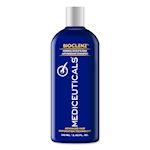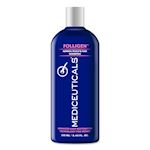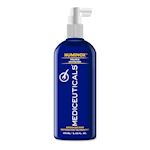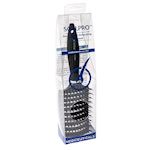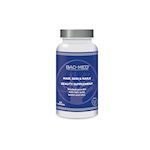-
ALOPECIA AREATA: WHAT IS IT AND HOW DO YOU RECOGNIZE IT?
Do you suffer from excessive hair loss? And are you increasingly discovering bald spots on your head? Then you may suffer from alopecia areata, which literally means patchy baldness. Alopecia areata is an autoimmune disease that affects the hair roots. This happens in various places on the head, causing all the hair to fall out in those places. The hair continues to grow around those areas. So there is nothing special to note about that.
The baldness caused by alopecia areata is sometimes limited to the scalp, but can also occur in other places on your body.
-
WHAT IS ALOPECIA AREATA?
Alopecia areata is a common autoimmune disease that causes a local inflammatory reaction around the hair roots. This causes bald spots on the affected, hairy body parts. This autoimmune disease usually occurs in the scalp, but it can also affect the beard, eyebrows or pubic area. The bald spots on the head are characterized by a round or oval shape and can vary in size. In some cases, alopecia areata can also be found in the nails. This manifests itself in brittleness and crumbling of the nails.
Alopecia areata is very unpredictable and the hair loss is irregularly distributed. It is the body's own immune system that mistakenly attacks its own hair follicles, causing the hair roots to become inflamed. It is reassuring that hair loss is usually not permanent. The hair follicles are usually not permanently damaged by the inflammation. This means that with the right treatment it is often possible to regrow the hair.
In severe cases (5-10%) of alopecia areata, all the hair on the head falls out, also called alopecia totalis. When all body hair is lost, we speak of alopecia universalis, which only occurs in 1 to 2% of patients.
WHO SUFFERS FROM ALOPECIA AREATA?
Alopecia areata occurs in approximately 0.05 to 0.1% of the population, regardless of gender or age. However, most patients get their first bald spots before they are 30. In addition, there is an increased risk of alopecia areata if the disease runs in the family. Heredity probably plays a role in 1 in 10 patients. People who already have an autoimmune disease are also at greater risk for alopecia areata. The same applies to people with eczema, asthma or hay fever.
WHAT ARE THE CAUSES?
The exact causes of alopecia areata are unknown. However, alopecia areata patients often also suffer from other autoimmune diseases. This includes thyroid disorders or certain forms of eczema, psoriasis, asthma, allergies and anemia. And if they don't have these autoimmune diseases themselves, family members often do. In addition, alopecia areata also appears to have a genetic component, with several people within the same family suffering from it.
It is also not yet known what exactly triggers the autoimmune response. Sometimes alopecia areata manifests itself after a lot of stress, an infection or the use of some medications. These factors do not cause the disease, but they may activate the disease.
WHAT IS THE COURSE OF THE DISEASE?
The course of alopecia areata is different for every patient. In 70 to 80% of people with the disease, the hair grows back within 1 to 2 years. The inflammation only affects the hair itself, not the hair roots. So once the inflammation heals, hair growth often returns. Unfortunately, the chance of the hair returning is smaller if:
- The hair parting on the top of the head is affected.
- Hair loss has been present since childhood.
- The patient also suffers from other autoimmune diseases.
HOW CAN ALOPECIA AREATA BE RECOGNIZED?
Hair loss can have several causes. That is why it is good to know exactly which symptoms alopecia areata can be recognized by:
Round or irregular bald spots on the head
The first bald spots on the head with alopecia areata are usually the size of a coin. The bald spot feels smooth. The hair loss may remain irregular, but it may also be that all the hair falls out.
Tingling
There are alopecia areata patients who suffer from a slight tingling sensation on the scalp.
Lots of hair loss in a short time
Hair loss often happens quite quickly. Within a short period, a lot of hair falls out and bald spots appear on the head.
Hair loss on other parts of the body
Sometimes hair loss is limited to the scalp, but it can also occur in other places on the body. Bald spots on the beard or eyebrows are a sign that it may be alopecia areata.
WHAT TREATMENT IS POSSIBLE?
Because the cause of alopecia areata is still unknown, the best treatment for it is also uncertain. The doctor will therefore initially wait to see whether the hairs return. However, treatment is possible immediately if desired. The treatment method depends on the stage the alopecia areata patient is in.
Dermatologists generally choose the following treatments:
- Medications: Corticosteroids, Ciclosporin, Dithranol or Minoxidil
- Local immunotherapy
- Gene therapy
- Light therapy
- Ultraviolet treatment
- Stimulus therapy
- Psychodermatology
- Alternative cure
Hair transplantation is not recommended, because the transplanted hairs may fall out again.
STIMULATE HAIR GROWTH IN ALOPECIA AREATA
Because finding the right treatment is often difficult, we recommend that you always look into ways to stimulate hair growth for alopecia areata. This will not prevent new bald spots from developing, but the hair will grow back faster.
At Mediceuticals we have a number of shampoos and conditioners that are part of our Advanced Hair Restoration Technology line. These products prevent excessive hair loss and combat thinning hair. In addition, they penetrate into the hair follicles where they stimulate the production of new hair growth. Always use a shampoo and conditioner from this hair care line and use them according to the instructions on the packaging. Then treat the scalp with the Numinox spray. Spray the Numinox twice a day close up on the scalp and spread over the entire scalp with your fingertips. Do not rinse the spray. After application, the scalp may show a red glow and some tingling. This is a normal reaction and disappears after approximately 20 minutes.
To give hair growth an extra boost, Mediceuticals also has a nutritional supplement. The Bao-Med hair, skin and nails beauty supplement is 100% vegan and helps strengthen the hair, skin and nails. The supplement can also help you if you suffer from brittle nails that crumble due to alopecia areata.
A LIFE WITH ALOPECIA AREATA
Hair loss due to alopecia areata is annoying. Especially because the cause of the autoimmune disease is still unknown and the treatment is still uncertain. One good thing is that the hair on the bald spots on the head often grows back. It just takes some time. Give your hair time to grow back and support that process by using the right products. If there is a lot of hair loss, it is also possible to (temporarily) wear a wig or hairpiece.
-
DO YOU WANT MORE INFORMATION ABOUT MEDICEUTICALS?
For personal advice you can contact us or make an appointment at one of our certified Mediceuticals salons.




